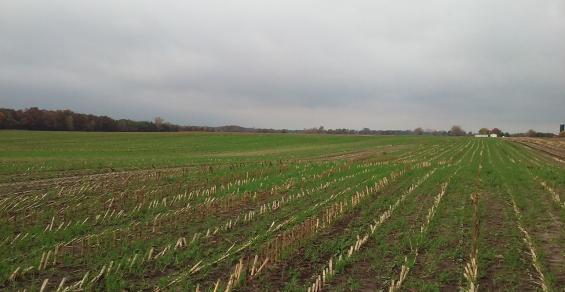Dairy Program: The same species can be used as cover crops or as forage mixtures, but they should be managed differently.
Cover crops, winter cereal forages such as cereal rye and triticale, and summer annual mixtures are covering more acres than in the past. Many species selected to protect soil and water quality are the same ones used in annual forage mixtures. While these crops can serve a dual purpose, management differs depending on their intended use.
Even if using the same seed, the seeding rate, blend or mixture of seed species, fertilizer strategy, and preferred planting date change depending on whether their purpose is as a cover crop or forage.
Primary uses of a cover crop are to scavenge and capture nutrients that otherwise may leach away or be lost from the root zone, and to mitigate soil loss. As a result, the amount of fertilizer applied to establish and grow a cover crop would be less than the amount applied to an annual forage mix with the main goal of dry matter yield.
Another reason to limit or not apply fertilizer to a cover crop, based on soil test results, is that unless the cover crop is diverted for forage, it generates no cash income. The budget is low input. Cover crop species as components of an annual alternative forage cocktail mixture including Italian ryegrass, winter and annual cereals, warm-season annuals, brassicas, etc., have been documented to respond to nitrogen fertilizer applications when harvested as forage for dairy and livestock operations.
Luxury consumption
Preliminary University of Wisconsin research, according to Jones and Jarek, has identified annual forage mixtures as responsive to nitrogen applications, increasing in yield at rates of up to 180 pounds N per acre, in some instances. That is a big appetite for nitrogen. When a crop consumes excess nutrients but does not increase in dry matter yield, it is considered “luxury consumption.” Luxury consumption of nitrogen in annual alternative forage crops may result in a higher-protein forage, reducing purchased protein costs and improving animal performance. Luxury consumption of potassium may have some value for lactating animals, and it will be returned to the field in the form of manure, not lost to the farm. Luxury consumption is less of a concern with forages than with cash crops.
Warm-season annuals such as millet and the sorghum-sudan group are also very responsive to N applications and require additional management to maximize dry matter yield and quality if intended for forage instead of cover.
UW-recommended seeding rates will generally be higher when growing species as a forage mixture rather than as a cover crop. Triticale and rye are similarly related species. Triticale was developed specifically for higher-quality forage production and is more expensive seed; it is often selected over rye if being grown to feed cattle. In addition, triticale holds maturity and quality longer than rye, providing better forage quality as measured by neutral detergent fiber and NDF digestibility. However, as a cover crop, rye will likely perform better under less-than-ideal or more difficult growing conditions.
Another example of same species different application is planting date. Rye is known to successfully establish even when planted well into November, but the yield potential will be less, to the point that it probably will not be a valuable forage crop. A planting date in September to early or mid-October and a heavier planting rate often show a yield response.
Consider crop diversity
There is value in diversity. Multiple species planted together increase the likelihood that one of the planted crops will respond favorably during adverse weather conditions. Does that mean “the more, the merrier” for cover crops and forage mixtures? Some species probably should not be included in forage mixtures but are desirable cover crops. Sunflower comes to mind. However, in extreme need (lack of other crop seed availability), they could be used. Some turnips, radish and other root crops may be usable in a grazing system, but not as desirable for mechanically harvested forage.
The same species, including the same varieties, can and are successfully being used as cover crops or as forage mixtures. However, they should be managed differently. Higher seeding rates, managed N fertilizer application rates, timing of fertilizer application and more timely planting dates are typically needed for successful forage mixtures, which are becoming more widely accepted for their ability to provide a combination of significant dry matter yield and high-quality feed.
Alternative forage mixtures, fall-seeded, cool-season and warm-season are showing up as some of the best for high yields of highly digestible fiber. They also use the ends of the seasons, providing more flexibility to cropping systems intended for livestock.
Lippert is the University of Wisconsin Extension dairy and livestock agent for Wood and Clark counties.




